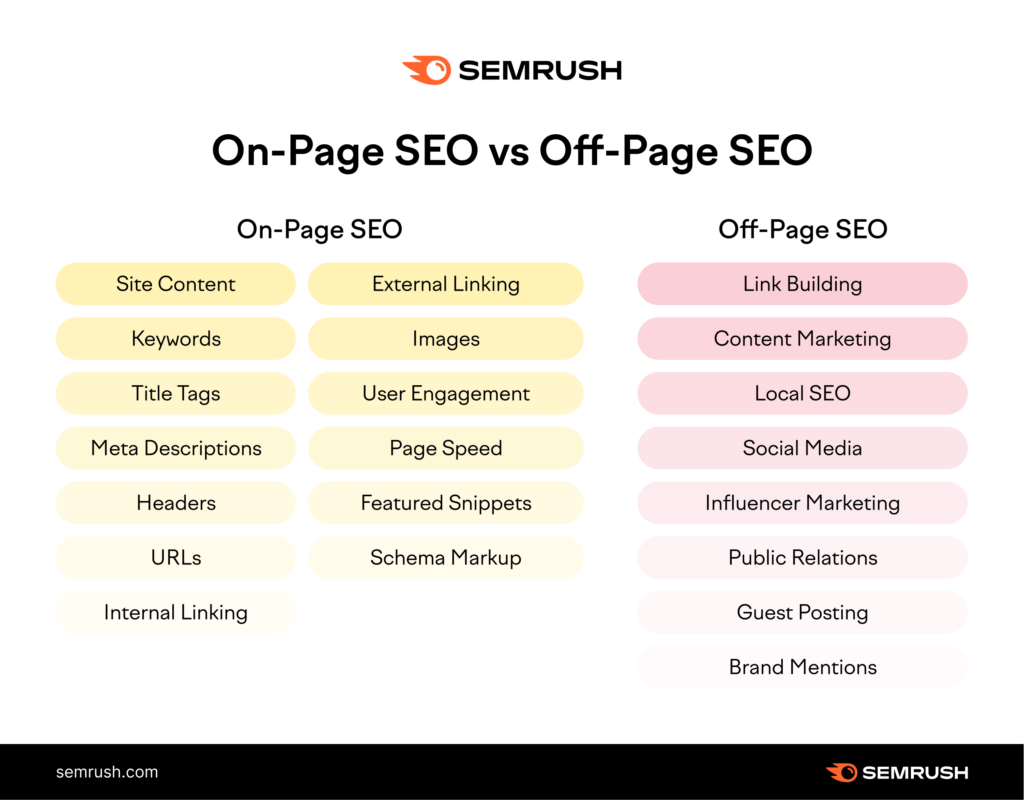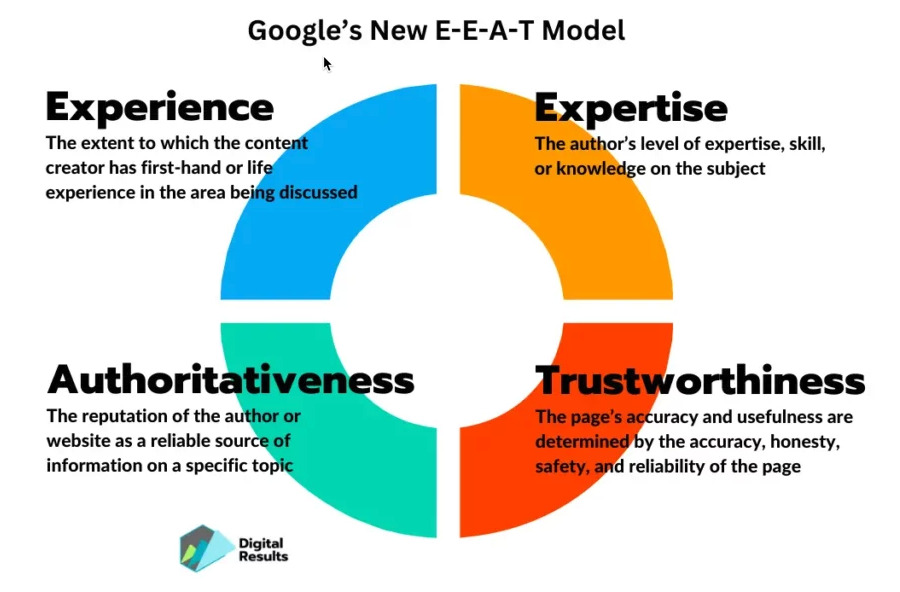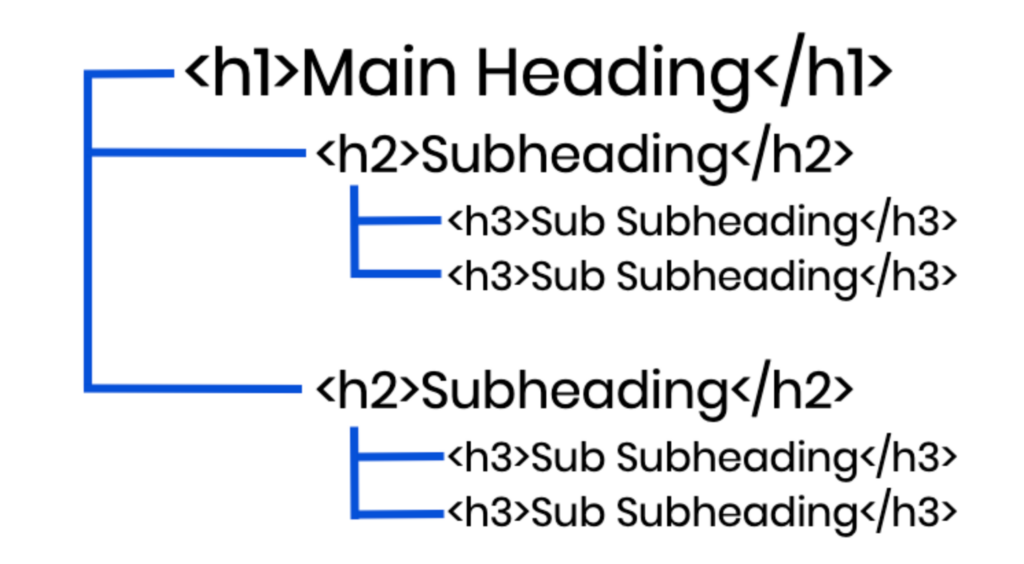Updated 2/22/23 to include new information.
On-page SEO is more than a checklist of factors that you need to optimize and maintain. It’s the gateway to getting your content in front of users, growing your brand, and maintaining a loyal customer base.
In this blog post, I’ll explain what on-page SEO is, why it’s important, how it differs from off-page SEO, and demystify which factors to consider when making on-page SEO optimizations.
What is On-Page SEO?
On-page SEO is the process of optimizing various factors of a web page to improve its rank in Google and other search engines. It includes optimization of headers, title tags, meta descriptions, and other crucial on-page factors that appear directly on the landing page and within the HTML source code (more on this later).
It’s called “on-page” SEO because all optimizations happen directly on your pages.
Why Is On-Page SEO Important?
On-page SEO improves the quality of your web pages so that search engines can understand them and rank them higher in search results. If a page shows up in search, it is more likely to increase traffic and even help with conversions. Additionally, on-page SEO optimizations help improve user experience and content accessibility.
On-Page SEO vs. Off-Page SEO
Although both are important for rankings and search visibility, on-page and off-page SEO each solve for different SEO factors.
On-page SEO focuses on optimizing factors directly on your website. Those factors, such as H1-H6 header tags, title tags, meta descriptions, image alt text, etc., are easier to control and maintain.
On the other hand, off-page SEO focuses on factors outside your website and involves optimization tactics such as link building, guest posting, brand mentions, and so on.

How to Improve On-Page SEO
To improve on-page SEO, you need to familiarize yourself with the on-page factors search engines look at to understand the content of a webpage.
Let’s get to know on-page factors that impact SEO.
1. Conduct Keyword Research
Keyword research is the process of discovering what keywords and phrases your target audience uses to search for the topic you want to show up for in organic search results. The goal of keyword research is to find keywords that can drive traffic to your website.
For instance, had I not checked to see what else people are searching for in relation to the keyword “on-page SEO,” I might’ve missed the fact that folks are frequently searching for an on-page SEO checklist:

Tips for keyword research:
- Use tools like Google Keyword Planner, Ahrefs, Semrush, etc.
- Choose 1-3 primary keywords to target per page.
- Pay attention to search volume and difficulty metrics.
- Align keywords with search intent.
- Analyze competitor keywords.
- Bonus: target long-tail keywords whenever applicable.
2. Write Content with E-E-A-T in Mind
E-E-A-T is an acronym coined by Google that stands for Experience, Expertise, Authority, and Trust. While it’s not a direct ranking factor, the quality of E-E-A-T helps Google determine if the content can be trusted.

Tips for E-E-A-T first content:
- Reference first-hand or life experience.
- Showcase subject matter expertise (e.g., use data, research, etc.)
- Establish yourself as a credible source by citing high-quality content
- Include accurate, useful, and up-to-date information.
3. Use H1-H6 Header Tags
H1-H6 header tags are HTML elements that create a visual hierarchy of a web page, which helps users and search engines quickly scan and interpret the content of a web page.
Maintaining hierarchy through header tags is a crucial aspect of on-page SEO. You’ll want to start with a single H1 tag, followed by H2 and H3 subheadings. The page structure should look something like this:

If additional header tags are needed, continue to use the rest of the H4-H6 tags in the same hierarchical order.
Tips for header tag optimization:
- Include the H1 tag above all other subheadings.
- Apply no more than one H1 tag per page.
- Use H2-H6 subheadings to break up heavy copy.
- Incorporate target keywords naturally.
Bonus: make sure your headers pass the blank sheet of paper test.
4. Write Captivating Title Tags
Title tags provide a brief web page summary and help users and search engines understand what the page is about. They appear in search results, browser tabs, and social media posts.

A title tag is an important on-page SEO factor and should be added to all pages you want search engines to find and rank. We also know that search engines like Google use the title tag as a minor ranking factor, making it much more valuable for on-page optimization.
Tips for title tag optimization:
- Keep them between 50-60 characters. Any longer, and Google will truncate them.
- Include target keywords. Preferably at the beginning of the title tag.
- Consider the user. Show them you have what they’re looking for.
- Be descriptive. Check to make sure the title tag reads well on its own.
5. Write Enticing Meta Descriptions
Meta descriptions appear in search results below the title tag. Though they’re not considered a ranking factor, they’re an essential aspect of on-page SEO as they help improve click-through rates.

Meta descriptions hold valuable real estate in search results and can help drive clicks and traffic.
Tips for meta description optimization:
- Keep them under 160 characters for regular pages.
- Include target keywords. Google is more likely to bold them.
- Use them as an extension of the title tag. Include additional context you couldn’t fit there.
- Explain the value of the page. Consider what the user is trying to accomplish.
6. Use Clean URLs
Clean URLs are easy to read and understand. It’s important to review URLs before publishing a web page because most Content Management Systems (CMS) will auto-generate the URL based on the title of a web page.
For instance, if I didn’t override the URL for this blog post, our CMS would’ve used:: https://portent.com/blog/seo/on-page-seo-guide-how-to-optimize-landing-pages-for-search.htm
Instead of: https://portent.com/blog/seo/on-page-seo.htm
Not only is the auto-generated option long and wordy, it also becomes truncated in search results:

Tips for URL optimization:
- Keep URLs word count to a minimum.
- Use hyphens to separate words. Using anything besides hyphens is a bad practice.
- Use lowercase letters.
- Incorporate target keywords.
Important: if you update URLs retroactively, remember to set up proper redirects!
If you want to check and see how your title tags, meta descriptions, and URLs will appear in the SERPs before adding them to your site, check out Portent’s SERP Preview Tool.
7. Add Image Alt Text
Image alt text, which stands for “alternative text,” is the text used to describe a non-decorative image used within the body of a landing page.
Image alt text helps search engines understand and index images properly. It’s also imperative for users with screen readers because it improves the image’s readability.

Tips for alt text optimization:
- Keep your description under 140 characters – about the length of a tweet.
- Write an accurate and concise description of the image (think stock image names).
- When applicable, use target keywords to reinforce the page’s relevance.
8. Include Internal Links
Internal links are the links that point from one page of your website to another. Since older pages typically have higher page authority, linking new pages to older content helps search engines find and rank them.
Tips for internal linking optimization:
- Use descriptive anchor text, avoiding generic text such as ‘‘as mentioned here,’ ‘see in this chart,’ and ‘this link.’
- Ensure the content you’re linking to is relevant.
- Link blog posts (and other highly trafficked pages) to product and/or service pages.
9. Include External Links
External links are the links from other websites you may link to within your content. Using external links may help establish the credibility of your content, which, if you recall from earlier, is important for E-E-A-T.
Tips for external linking optimization:
- Link to credible sources (e.g., third-party data, original research, etc.)
- Use external links sparingly (link to your content whenever possible).
- In your CMS, set external links to open in a new window so that the user doesn’t accidentally exit from your website.
Advanced On-Page SEO Factors
Some aspects of on-page SEO are more complex than others. And while you can learn to make the more advanced on-page optimizations on your own, those opportunities tend to be more complex and should be addressed by someone with a deep understanding of Technical SEO.
In this section, I’ll cover the most common advanced on-page SEO factors we run against. However, instead of providing tips on optimizing them, I’ll share a few resources from our Portent blog. Should you need additional support, feel free to contact us! We’re here to help.
10. Improve Page Speed
Page speed is the amount of time it takes to fully display the content of a landing page. It’s an important ranking factor, as websites with faster page speed have better user engagement and higher conversion metrics.
Page speed can be impacted by many factors, such as redirects, image quality, CSS and JavaScript files, etc.
To learn about your page speed performance, check out Google’s Page Speed Insights to better understand your mobile and desktop performance.

For more information on page speed, check out our blog post: How Page Speed Affects Conversions
11. Target Featured Snippets
Featured snippets are short pieces of text carefully extracted by Google to provide a concise and direct answer to the user search. They’re displayed at the top of organic search results and come in several formats, such as paragraphs, lists, and tables.

Disclaimer: to qualify for a featured snippet placement, your landing page must first rank on the first page of Google’s organic search results.
For more information on featured snippets, check out our blog post: How to Compete for Featured Snippets in Google.
12. Use Structured Data Markup
Structured Data markup is a form of metadata that helps search engines understand what the page is about. You can describe many types of content with structured data, such as articles, recipes, events, products, reviews, videos, etc. Some rich snippet types are only available to pages that use this markup. Google lists their supported rich snippet types here.
The different types of data you can mark up can be found at Schema.org – “collaborative, community activity with a mission to create, maintain, and promote schemas for structured data on the Internet, on web pages, in email messages, and beyond.” This resource can take the guesswork out of what Google and other search engines expect when structuring your data.
For more information on structured data markup, check out our blog post: Introduction to Schema Markup for SEO
To Recap
Now that you know what it takes to keep your on-page SEO in tip-top shape, you’re ready to optimize your content! I’ve provided the information in this post in a quick-reference checklist below to help you get started optimizing your landing pages.
On-page SEO Checklist
Use the following checklist as a starting point to evaluate the essential on-page SEO factors on your landing pages.
- Conduct Keyword Research: use keyword research tools, target no more than three primary keywords per page, pay attention to keyword metrics, align keywords with search intent, and analyze competitors.
- Write Content with E-E-A-T in Mind: reference first-hand experience, showcase subject matter expertise, establish yourself as a credible source, and include accurate information.
- Use H1-H6 Header Tags: include the H1 tag above all other subheadings and no more than once per page; use H2-H6 subheadings to break up the heavy copy and incorporate target keywords.
- Write Captivating Title Tags: keep them between 50-60 characters, include target keywords, consider the user, and be descriptive.
- Write Enticing Meta Descriptions: keep them under 160 characters, include target keywords, add context that compliments your title tag, and explain the page’s value.
- Use Clean URLs: keep URL word count to a minimum, use hyphens and lowercase letters, and incorporate target keywords.
- Add Image Alt Text: keep them below 140 characters, write accurate and concise image descriptions and (when applicable) use target keywords.
- Include Internal Links: use descriptive anchor text, link to relevant content, and link blog posts (and other highly trafficked pages) to product and/or service pages.
- Include External Links: link to credible sources, use links sparingly and set links to open in a new window.
- (Advanced) Improve Page Speed: read Why Page Speed Matters
- (Advanced) Target Featured Snippets: read How to Compete for Featured Snippets in Google
- (Advanced) Use Structured Data Markup: read Introduction to Schema Markup for SEO










Thanks for a really useful brief introduction to on-page SEO. I knew some of this but how you take people through the different parts of the page is really helpful.
Sean
Thanks for this tool! I stumbled upon your site a few days ago and am glad I did. Great info (plus lots of personality). 🙂
I want to thank you for sharing your knowledge. I posted on my blog to share this with other people. Keep up the good work!
This is a good start for someone who has an understanding of SEO, a good reference point. It is my hope however, that they do completely understand the concepts behind SEO, it isn’t as easy as just sticking your catchphrase or keywords around your site, SEO is a process that works over time, it’s not a quick fix deal. Again, great reference!
Loved the tutorial – it’s nothing new to me, but I can see it would be if someone had not known the basics. Solid information, and great ads on Facebook, by the way!
You’re obviously top-notch. I’ll try to peek in often – two thumbs up, for what it’s worth.
A comment on schema mark-up would make an even dozen.
Great article Kat Shereko, great stuff. I have always been annoyed at how my search results never match the landing page at all. I am on the verge of starting my own start-up soon, will definitely make sure to incorporate your advice. Thanks for sharing.
Thank you for the kind words, Ravi. I’d love to hear how things go once you put our recommendations to the test!